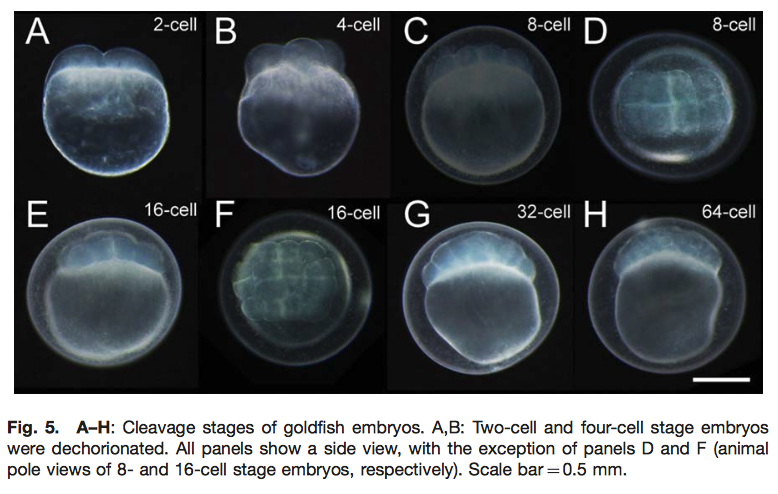Embryonic Development of Goldfish (Carassius
auratus): A Model for the Study of
Evolutionary Change in Developmental
Mechanisms by Artificial Selection
Background: Highly divergent morphology among the different goldfish strains (Carassius auratus) may make it a suitable model for investigating how artificial selection has altered developmental mechanisms. Here we describe the embryological development of the common goldfish (the single fin Wakin), which retains the ancestral morphology of this species. Results: We divided goldfish embryonic development into seven periods consisting of 34 stages, using previously reported developmental indices of zebrafish and goldfish. Although several differences were identified in terms of their yolk size, epiboly process, pig- mentation patterns, and development rate, our results indicate that the embryonic features of these two teleost species are highly similar in their overall morphology from the zygote to hatching stage. Conclusions: These results provide an opportunity for further study of the evolutionary relationship between domestication and development, through applying well-established zebrafish molecular biological resources to goldfish embryos. Developmental Dynamics 242:1262–1283, 2013. VC 2013 Wiley Periodicals, Inc.
Background: Highly divergent morphology among the different goldfish strains (Carassius auratus) may make it a suitable model for investigating how artificial selection has altered developmental mechanisms. Here we describe the embryological development of the common goldfish (the single fin Wakin), which retains the ancestral morphology of this species. Results: We divided goldfish embryonic development into seven periods consisting of 34 stages, using previously reported developmental indices of zebrafish and goldfish. Although several differences were identified in terms of their yolk size, epiboly process, pig- mentation patterns, and development rate, our results indicate that the embryonic features of these two teleost species are highly similar in their overall morphology from the zygote to hatching stage. Conclusions: These results provide an opportunity for further study of the evolutionary relationship between domestication and development, through applying well-established zebrafish molecular biological resources to goldfish embryos. Developmental Dynamics 242:1262–1283, 2013. VC 2013 Wiley Periodicals, Inc.







